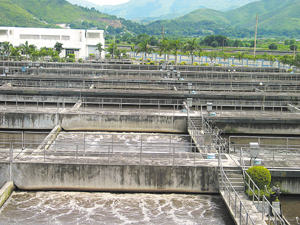| Home / English Column / Environment / Environment -- What's New | Tools: Save | Print | E-mail | Most Read |
| 'Ocean Reservoir' to Tackle Water Shortage |
| Adjust font size: |
An "ocean reservoir" could be built to help alleviate future water shortages in Shenzhen. Experts warn shortages could affect people's daily lives and the city's economic growth in the coming years. The city's water supply capability currently stands at 1.9 billion cubic meters of water a year. But researchers believe it may need an extra 360 million cubic meters in 2010, 1 billion cubic meters in 2020 and 1.4 billion cubic meters in 2030 to support the normal operation of its fast-growing society. The statistics are from the nation's first government-organized study that comprehensively addresses the water problem. The report suggests looking at the feasibility of building a reservoir, which could contain 200 million cubic meters of water, in the sea off eastern Shenzhen. It would collect a large quantity of fresh water before it runs into the sea. It would need a type of membrane that could separate the fresh water from the salty water in the sea. Currently, a number of Chinese cities, including Macao and Shanghai, have set up such reservoirs but the one in Shenzhen, if implemented, would be the country's largest-scale reservoir in the sea. The report is part of the municipal government's efforts to strategically plan its future development up to 2030. The ultimate goal of Shenzhen, one of the seven Chinese cities that suffer with the most serious water shortages, is to remove every factor that threatens its water supply and become a place enjoying sufficient water resources. The report reiterates the importance of conserving water, and introduces a number of new measures to ensure sufficient supply.
Because of the widespread availability of water-saving technologies and industrial upgrades, the water consumption of each person could be reduced to 200 liters a day in 2010 and to 185 liters in 2030, from the current 220 liters, according to the study. The amount of water used for generating every 10,000 yuan (US$1,233) of industrial added value would also be cut from the 26.4 cubic meters at present to 20 cubic meters in 2010 and 13 cubic meters in 2030. Since 70 percent of the water supply is sourced from outside of the city, mainly from Dongjiang River, the report suggests exploring a second water source and increasing the content of local reservoirs. "If our main water source was polluted and the pollutant could not be removed in a short time, the city's water supply system would face a very serious challenge," said Du Yan, one of the senior experts responsible for conducting the research. The second phase of the Dongjiang project, with an investment of 550 million yuan (US$67.8 million), began construction in February and is expected to be completed in two years. It will create an additional 370 million cubic meters of water to the city annually. It could temporarily ensure normal water supplies to the city in case of emergencies by 2010. There is also the possibility to source water from Xijiang River, another branch of Pearl River, China's third longest river, the report suggests. Zhang Yue, an official with the Ministry of Construction, told a seminar recently that the Shenzhen municipal government could co-operate with other Guangdong cities, which are facing the same accelerating water problems, to develop the project. (China Daily March 2, 2006) |
| Tools: Save | Print | E-mail | Most Read |
 |
| Related Stories |
|
